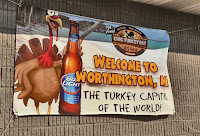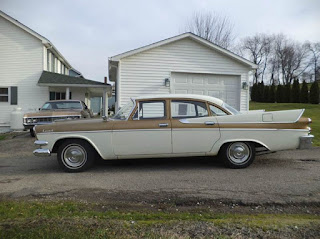Me Llamo Worthington, MN
Monday September 9 – Caledonia,
Minnesota-Worthington, Minnesota
As I break camp this morning it is cloudy and
cool, the temperature is in the 60s. I am surprised then when I walk into Elsie’s
Bar and Grill, my Caledonia headquarters, and hear people talking about a
forecast of record breaking temps around 100°.
There are Elsie’s kinds of places in
almost every small town I’ve visited, even the dying towns. It’s the place
where the ol’ boys go for a sunrise breakfast, hot coffee and to talk the
weather, tractors and hog prices. You can get two over medium, bacon, hash
browns and coffee for $3.95, biscuits and gravy $4.95.
If you’re in a hurry, you can sit at
the counter. The skinny bleached blonde waitress in jeans way too tight for her
age, a face heavily made-up to hide the hard lifelines and a cigarette raspy
voice will take your order and call you honey. The bar is in the back and later
in the morning the older ol’ boys will filter in and start playing poker. I
love Elsie’s! By the time I leave after eating and writing an hour and a half
later the sun is blazing and I know the forecast is correct.
I’ll have to travel almost 150 miles on I-90
west today to Worthington at the other end of the state but first I’ll enjoy
about 80 miles on mostly county and state roads. I am surprised at the
condition of Minnesota’s state highways; they are in terrible disrepair, by far
the worst I’ve seen. There are cracks and bumps in the surfaces, providing a
jarring ride I usually experience on the county roads. More surprising, I see
little or no roadwork along the way.
These roads are twisty and rolling with plenty
of farmland still around me. After awhile, the road straightens and the land
flattens. The crops are mostly corn and soybean in fact; I’m seeing some of the
largest cornfields ever. I am also seeing more wind farms than I’ve seen any
place else. At one point these giant windmills on either side of the road stand
as far as the eye can see. The wind power production industry has definitely
taken hold across America. Am I the only one just realizing that?
 I stop
for gas on the outskirts of Worthington and I’m struck by a sign in the
convenience store window, “Welcome to Worthington, MN, Turkey Capital (sic) of
the World!” Being the wiseass that I am, even to myself, I wonder, “Are they
talking about birds or people?”
I stop
for gas on the outskirts of Worthington and I’m struck by a sign in the
convenience store window, “Welcome to Worthington, MN, Turkey Capital (sic) of
the World!” Being the wiseass that I am, even to myself, I wonder, “Are they
talking about birds or people?”Tuesday September 10 – Worthington, MN
 This is the second time on my journey I am staying
in a city park campground and, again, it is a delight. The rate is great –
$18.00 a night – and the location fabulous. Not only is it convenient to
downtown, the park, as well as the city, sits on Lake Okabena. It is a small
natural lake, one-point-two square miles, located entirely within the city.
This is the second time on my journey I am staying
in a city park campground and, again, it is a delight. The rate is great –
$18.00 a night – and the location fabulous. Not only is it convenient to
downtown, the park, as well as the city, sits on Lake Okabena. It is a small
natural lake, one-point-two square miles, located entirely within the city.
Lake Okabena and the surrounding area were first
mapped in 1841 by French explorer Joseph Nicollet. He dubbed the area Sisseton
Country in honor of the local band of the Dakota Sioux. He named the lake using
the Sioux word for “home of the heron.” The City of Worthington would be incorporated
about 30-years later and it has a curious history. Take the town’s name for
example.
Many locations are named for heroes, leaders,
royalty, founders, explorers, local native tribes and chiefs; Washington,
Lafayette, New York, Pennsylvania, Pikes Peak, Seattle and Georgia, for
example. One of Worthington’s founders went an entirely different direction; he
took for the town’s designation his mother-in-law’s maiden name. Go figure.
From the beginning Worthington was a railroad
town. It was originally called The Okabena Railway Station because that was the
locale’s original purpose, to serve as a way station between the two termini of
the St. Paul & Sioux City Railway. That same year, 1871, Professor Ransom
Humiston of Cleveland and Toledo Blade editor Dr. A.P. Miller formed a company
to locate a colony of settlers along the new rail line. They chose the Okabena
Station as their location and it was Dr. Miller who changed the name to honor
his M-I-L. Go figure. The rail yards in Worthington are still active today.

I learned of another, more curious piece of local – and more recent – history after I arrived in town. The second thing I noticed after the Turkey Capital of the World sign was the number of bodega’s (three) and Mexican restaurants (two) along the three or four blocks of Worthington’s main drag. This is a town of about 13,000 people and that seems like a lot of Hispanic commerce. So I am mildly shocked to learn that a little more than a third of Worthington’s population is Hispanic. So, even the Anglo businesses must serve their entire community.
One-third is not a very big number if you compare it
to cities like Laredo, TX where more than 90 percent of the people are
Hispanic. Laredo is on the Mexican border; THIS is Minnesota, on the Canadian
border. Curious.
The answer is economics, pure economics – and
pigs not turkeys. In the mid-1980s a farm crisis nearly killed Worthington and
the population began to rapidly decline. There were only about 100 Hispanics
here in the mid 80s. At the same time, the town’s largest employer, a pork
processing plant changed hands (today it is owned by Swift). The new owners
added a shift and dramatically cut wages. As word of this spread, hundreds of
lower income minorities began to arrive, primarily Hispanics. Today, more than
2,000 people work at the plant.
It’s been a mixed blessing for Worthington. On
the one hand, JBS Swift & Co[1],
the plant’s official name, helped shield the area from the worst of The Great
Recession. Worthington’s unemployment rate “peaked” at five-point-five percent
in 2010-11 and sits somewhere in the fours now. But the immigrant inflow brought
the attendant problems that come along with such a dramatic demographic shift.
Ryan McGaughy is Managing Editor for the
Worthington Daily Globe. He’s been with the newspaper for 12 years, first as a
sports reporter, moving over to the news side and eventually to the Big Desk in
2006. He says the inflow of immigrants initially caused the predictable
division within the town between those who thought it would ruin the city and
those who saw it as a positive thing. There’s a little bit of truth on both
sides.
“You might notice there’s a lot of construction
going on,” he tells me. We built a new hospital, a brand new event center and a
new supermarket. But our biggest challenge as a community is housing. Many of
the lower wage workers are buying the older homes and they have multiple
occupants because there just isn’t enough housing stock for them.”
“It’s going to take a major combined effort to
address the challenge. You have the city and the county – even the state has
gotten involved to an extent. JBS is also at the table because they realize
their people need housing. It will take that kind of joint effort because Joe
Schmoe local developer isn’t going to go investing in housing here.”
I then turned to McGaughy’s personal story. He
is, after all, in an industry that was all but dying before the recession
began. “I don’t want to say we’re closing our doors; we’re certainly not,” he
explains, “but revenue has been harder to come by, that’s for sure and it
accelerated during the recession.”
“Do you fear for your job?” I ask.
“I don’t think my job is threatened, per se but
I do fear that one day I’ll come in and someone will tell me they’re going to
centralize and say, for example, do the layout for the paper in Fargo where our
company headquarters is located.”
Finally, I can’t help myself and ask McCaughy, “So,
why are you the turkey capitol and not the pig capitol of the world?”
He laughs, “Oh that’s from the 20s and 30s when
we had a real turkey industry. Today there isn’t a turkey plant in Worthington.”
But, the town does celebrate its turkey heritage
every September with Turkey Days, complete with turkey races. The participating
turkeys are ringers, though; they have to be imported for the event.
---
Afternote: You might be asking yourself, "Why didn't he interview any of the Hispanics in Worthington?" Lord knows I tried.
 I walked into one of the restaurants, one of the bodega's and stopped several folks on the street. Nada.
I walked into one of the restaurants, one of the bodega's and stopped several folks on the street. Nada.
Maybe they didn't trust a scruffy gringo in a straw fedora or maybe, just maybe, they are still gun shy after the 2006 raid.
Afternote: You might be asking yourself, "Why didn't he interview any of the Hispanics in Worthington?" Lord knows I tried.
 I walked into one of the restaurants, one of the bodega's and stopped several folks on the street. Nada.
I walked into one of the restaurants, one of the bodega's and stopped several folks on the street. Nada.Maybe they didn't trust a scruffy gringo in a straw fedora or maybe, just maybe, they are still gun shy after the 2006 raid.
[1] In 2006, the Worthington plant was one of several
Swift facilities around the country raided by the U.S. Immigration and
Naturalization Service for employing undocumented immigrants. More than 200
illegal workers were arrested in Worthington.




Comments